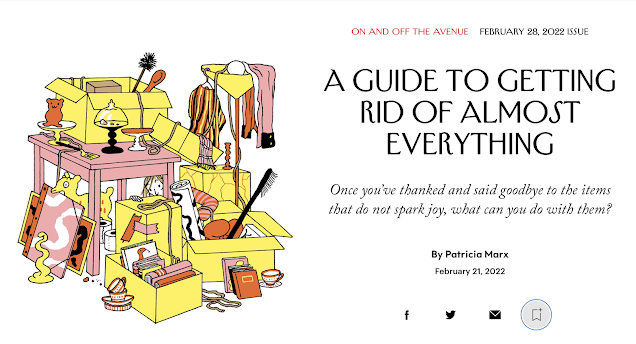Style: Frump finds its flock
Rarely has someone's journey rolled around in my head like that of Jessica Parker, who writes "No Accounting for Taste" on Substack. Parker has embarked on a close examination of her style—her entire self-presentation— in two insightful essays.
The first, "Rebuilding a sense of style, Part I", describes her decades of pain and shame concerning her body and attendant self-esteem, and her decision to finally stop trying to conform to rigid, impossible standards. Her bête noire is her round tummy. She discovers the attitude called "Frump", guided by a 2017 essay by Emma Copley Eisenberg, "Notes on Frump: A Style for the Rest of Us", among others, and jumps in belly first.
To its adherents, "Frump" is no longer a derogative term; the Frump, they believe, is seen for her true self, not just her ability to conform to a an unattainable standard of beauty. Its followers range from all-in to women who Frump when they fancy. They cite five key behaviours:
What is new about Frump is not the knee socks, but the liberation. Parker says, "As middle age renders me less visible in the world, the feeling of adopting frump and claiming my belly is like a warm cabin in the woods, with my weird garden (mugwort and rue, anyone?) and seven cats, crochet blankets and quilts made from all the clothing from my past that could not longer be worn."
I waited eagerly for the next part: what was Jessica Parker actually going to wear, newly freed of the voices in her head that told her to diet yet again or find "flattering" clothes for her shape? Frump is in the eye of the wearer; items one woman deems frumpy can seem fashionable to another. (Emma Copley Eisenberg expands the aesthetic beyond clothing here, a hard-core Frump manifesto.)
Part II is subtitled "My first day of Frump School". The classic Frump closet holds undelineated-waist dresses, clogs, loose tops, cardies. Frumps say the point is not to reject femininity, but rather the social imperatives to be sexy, hot, attractive, pretty. Doin' fine in my smock, thank you.
In the photos, Parker resembles my bank manager, teachers at the school across the street, and the female techies who work in my 'hood (except they're in lot more black)—the choices are familiar; every woman I know owns at least a few gateway Frump pieces.
I often see young Frumps in thrift stores, and before I even knew the term (in the modern, positive sense), noticed this twentyish woman letting her Frump flag fly:
There are a lot more around than you might think, if you include the Frump-adjacent, such as the modest dressers, Intentional Aunties, Coastal Grandmas (Frumps with money), and as a friend who lived there says, "women from Vermont."
Or maybe Minnesota? Gwen Walz, wife of Governor Tim Walz, US Presidential contender Kamala Harris' running mate, was praised in an article in The Cut by Valerie Monroe, when she made her first appearance related to the campaign in "a frumpy cardigan and shapeless above-the-knee shift". Monroe referred to Walz' look as "unmanipulated", "relaxed, easy" and "unequivocally like the real thing": a Frump home run.
As I looked at various posts of women in Frump attire, I did not feel drawn to the clothes, preferring a dollop more detail and ornamentation than Frump. This shot of a woman on the street in NYC in May, is an example:
 |
I would love to hear from you. Do you have a Frump side, or are you a confirmed Frump? Perhaps you would run in your Louboutins from even hint of that look?







Comments
I don't live in Vermont, but I do live in Oregon. Same same on the style front. The real challenge is to go somewhat upscale (think Eileen Fisher/semi-coastal whatever) without spending the proverbial arm and leg, never mind rolling the real ankle.
Frump for young women in my view, is fine, along with 5" heels, goth, prairie, skin tight dresses and anything else they want to give a go, because they ARE young. You get away with things then because you have all the rest of the positive aspects of youth - great skin, usually lovely body (even if not slender, it's still a young body with the grace and ease that implies), a sort of insouciance.
I think this is very dangerous territory for older women,who can often look unkempt and dirty in these sorts of garments, even if they aren't, as usually a lack of attention to grooming goes hand in hand with these clothes, as in no makeup, bad haircut, etc. I don't understand why they feel you can't have comfort and ease in garments that don't make them look like the char or that they've given up entirely. I do have clothes that are kept for home but I never go out the door in them. If they feel that they have become invisible, maybe it's because there's nothing to look at.
Recently, a friend brought a friend of hers over a few times. She dresses in a way I have not seen for decades: knee-length, fitted knit dresses, or a-line skirts and a blouse. Not at all Eileen Fisher: no ease, no layers. Very "lady". Ballet flats, small framed bag. It was charming and novel (but somehow did not look out of date), and entirely her. I liked the effect a lot. She remarked that she only wears trousers for gardening. Whole other look!